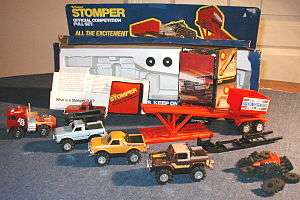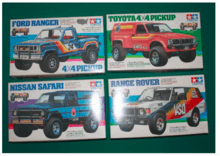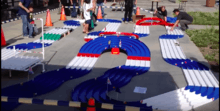Mini 4WD



Mini 4WD is any miniature model within the mini scale of between 1/20 (1:20) to 1/48 (1:48) scale. Currently, in 2015, the term is popularized predominantly by a 1/32 (1:32) scaled, AA battery powered plastic model race car without remote control. All four (4) wheels are direct-drive, thus "4WD" for 4-wheel drive, as opposed to "AWD" or All-wheel drive. Horizontal side rollers guide the vehicle against the vertical walls of the un-banked track for steering, providing very fast speeds up to 65 km/H[1] (40 mph) on the track. In Japan, Mini 4WD is also known as mini yonku (ミニ四駆) in Japanese.[2] Though mostly popular in Asia, they are sold in many countries as Japan, Taiwan, Hong Kong, South Korea, Philippines, Thailand, Indonesia, Malaysia, Italy, United States and the Netherlands.
History
In 1980, a mini 4WD series of vehicles called Stomper 4x4, were invented by Adolph Goldfarb and produced by Schaper. A multitude of replicas produced by other companies led to lengthy lawsuits, and eventually the company sold the product to Tyco, after which, sales declined.
In 1982, 4WD Mini Racer (ミニ四駆) was produced by the Japanese company Tamiya as a powered variant of their plastic automobile model kits. Since then racing and tuning up mini 4WD cars have become a hobby for people across the world.[3]
Beginning in 1982, Tamiya mini 4WD kits were sold by Model Rectifier Corp (MRC), the exclusive U.S. Distributor of Tamiya.[4] The kits were manufactured in Japan while the boxes were printed in Canada. The kit parts were then packaged into the boxes in Edison, New Jersey, USA. MRC continued to sell Mini 4WD kits until at least 1990, which may be the year their Tamiya license expired.
In 1989, Tamiya commissioned Shogakukan, a Japanese publishing company, to produce two anime TV series based on the Mini 4WD cars: Dash! Yonkuro by Zaurus Tokuda, Bakusō Kyōdai Let's & Go!!, Bakusou Kyoudai Let's & Go WGP in 1996, Bakusou Kyoudai Let's & Go MAX, and finally Bakusō Kyōdai Let's & Go!! WGP: Bousou Mini 4WD Daitsuiseki.
Also in 1989, Tamiya America was established in the United States and replaced MRC as the officially licensed distributor for Tamiya, in that country.[5] Headquartered in Irvine, California, Tamiya in the United States holds USA Mini 4WD Championships at Marukai Corporation U.S.A. in Gardena, California.
In 1999, Tamiya Japan temporarily suspended the Great Japan Cup world championships for Mini 4WD racers.
By the 2000s, at least twenty-eight (28) other companies had ventured into the Mini 4WD market, and famously included Tokyo Marui, Kyosho, Academy, Auldey Animation and Toys, Circuit no Ōkami, Aoshima Bunka Kyozai, Matchbox (brand), Revell, Hot Wheels, Tonka, Hasbro, and Bandai. Many of them introduced their own lines of mini cars, while some produce counterfeit replicas of Tamiya cars.[6]
Beginning again in 2006, Japan holds National Mini 4WD Championships in Spring, Summer and Autumn each year[7] and by 2012 Mini 4WD is popular in more countries including Thailand, Singapore, South Korea, Canada, Germany, Italy, Russia, India and China.
Guinness Book of World Records now shows the longest mini 4wd track in the world was set in Japan in October 2010 at 523.61 meters which record was quickly broken in Thailand in March 2011 at 1,074.5 meters at the Central World Mall sponsored by Panasonic. Three years later, on 1 February 2014, a new record was created at 1,188.67 m (3,899 ft 10.03 in), at Omiya Elementary School in Hitachioomiya, Ibaraki, Japan.[8]
Generation I (Schaper)
Stomper 4x4s was the first official mini 4wd, created on February 14, 1980, by Adolph Eddy Goldfarb[9] and sold by Schaper Toys. These toys were battery-powered vehicles that ran on a single AA battery and featured four-wheel drive. They were driven by a single motor that turned both axles. Of the first vehicles were a Ford Truck and a Chevrolet Truck.
Generation II (Tamiya)
In 1982, Mini 4WD was produced by Tamiya. These toys were battery-powered vehicles that ran on a pair of AA battery and featured four-wheel drive. They were driven by a single motor that turned both axles. Of the first vehicles were a Ford Truck and a Chevrolet Truck.
Generation III (Tamiya)
- In 1983, Tamiya produced a Racing Mini 4WD series starting with Hotshot Jr. and the Type-1 chassis. All Type-1 chassis kits were supplied with thick, big racing wheels and super slick spiked tires.[10]
- In 1984, Emperor and the Type-2 chassis were introduced. Like the Type-1 chassis kits, all Type-2 chassis kits also have spiked tires of the super slick type.
- In 1985, Vanquish Jr. and the Type-3 chassis with the standard large diameter tires and fin type wheels were introduced while the Type-2 Dash! Yonkuro cars were also re-released on the Type-3 with the same big racing wheels and smooth super slick tires.
- In 1989, Crimson Glory was released with the FM chassis, this unique chassis had the motor placed on the front of the chassis which was believed to give the car an upslope and downhill balance.
- And in 1990, the Manta Ray Jr. and the Zero chassis were produced.
Generation IV (Tamiya)
- In 1993, Tamiya produced a Super Mini 4WD series starting with Liberty Emperor and the Super-1 chassis and it is the first series to only use the standard large diameter wheels and tires.[10]
- In 1994, Strato Vector and the Super FM chassis were produced.
- And in 1995, Black Stalker and the Super TZ chassis were produced.
Generation V (Tamiya)
- In 1994, Tamiya produced a Fully Cowled Mini 4WD series starting with Magnum Saber on the Super-1 chassis and it is the first to have cars equipped with small diameter narrow wheels and tires.[10]
- In 1995, Cyclone Magnum was released with the Super TZ chassis and wide thread wheels and tires.
Generation VI (Tamiya)
- In 1998, Tamiya produced an Aero Mini 4WD series starting with Max Breaker and the Super X chassis. In the same year, a Mighty Mini 4WD series was produced starting with Dyna Hawk.[10]
- Also in 1998, Lightning Magnum and the VS chassis were introduced.
Generation VII (Tamiya)
In 2003, Tamiya produced the R/C Mini 4WD series starting with Subaru Impreza WRC 2002 and the TR-1 chassis, a chassis that runs with a receiver unit and a single-button radio controller. As the cheapest alternative to actual R/C cars and slot cars, the receiver unit is removable to let the car freely run on the track with just the motor and batteries, there were also car component kits and unique tune-up parts produced. However, the R/C Mini 4WD cars' popularity were not widespread after its introduction and Tamiya continued making free-running Mini 4WDs.
Generation VIII (Tamiya)
- In 2005, Tamiya produced the Mini 4WD PRO series starting with Nitro Thunder and the MS chassis, a chassis run by a dual-axle motor and can be separated into three parts: a front N-unit, rear T-unit and the midship unit containing the motor and batteries.
- In 2013, Tamiya created the MA chassis series of cars as a subseries to the PRO series starting with Blast Arrow. The MA chassis combines the aerodynamics and monocoque aesthetics of the AR chassis and the inner structure aspects of the MS chassis.
Generation IX (Tamiya)
- In 2010, Tamiya produced the Super-II chassis as the successor to the Super-1 chassis with more compatibility with optional parts meant for other chassis and as such were originally sold as premium versions of their original counterparts. Later in 2011, Tamiya started producing new Mini 4WDs on this chassis starting with the Astute RS.
- In 2012, Tamiya produced a Mini 4WD REV series starting with Aero Avante and the AR chassis, this new chassis has improved aerodynamics, easy motor and battery removal without removing the body part and a monocoque design.
Special/Limited Edition Mini 4WD models (Tamiya)
- In the late 90's when Let's & Go!! MAX was aired on television in Japan, Tamiya produced a series of display model kits known as the Mechanical Mini 4WD series (stylized as Mini 4WD Mechanical). The cars in this series are static replicas of the mechanized cars shown in the anime itself and thus they cannot freely move unlike the actual Mini 4WDs.
- Certain software, anime production companies and some regions in Japan also collaborated with Tamiya to merchandise the main and/or secondary characters of their anime, software mascots or even tourism icons for limited edition Mini 4WD kits through licensing as these companies believed that Mini 4WD is cheaper for them to invest in bulk quantities compared to R/C cars which are four to six times the price per kit in bulk.
Mini 4WD Design
In a standard 4WD design, the separate four wheels are allowed to rotate at different speeds through the use of differentials. This is important for cornering to eliminate binding. In a Mini 4WD, this is not a standard design and is only achieved through optional one-way wheel sets. Thus, the standard Mini 4WD utilizes a direct drive to all 4 wheels even around corners. Chassis' are designed to hold the motor and batteries in differing arrangements. There are sideways motors positioned in the rear. There are sideways motors positions in the front. There are in-line motors positioned in the middle. Rear and Front position motor designs position batteries side by side in the front or rear of the motor placement. Middle position motor designs position the batteries straddling either side of the motor. Rear and front position motor designs utilize a propeller rod extending from the main motor gear box that drives both the front and rear axles. Middle position motor design powers both the front and back wheels through separate gear boxes eliminating the need for such a propeller rod.
Chassis' are designed with front bumpers, optional side and rear bumpers designed to hold guide rollers that interact with the track's 58mm high walls.
The body is designed from hard plastic or soft, transparent Polycarbonate, known by the trademarked names Lexan, for special or limited editions, which attaches with a catch-type lock at the back of the car, distinguishes one model from another.
Motors
There are three specifications that characterize all motors: RPM, torque, and power-consumption.[11] RPM is the speed the motor provides, and the torque its strength. Higher the RPM means higher maximum speed ; Higher torque gives more acceleration and allows the car to better withstand the difficulties of climbing slope or running through turns.
Gears
Different types of gears have different ratios of rotation of the motor and the wheel, and they include "Super Speed" (3.5:1), "High Speed" (4:1), "Speed" (4.2:1), "Standard" (5:1), and "Special" (ratio varies but are usually 6.4:1). Higher the ratio, better the acceleration rate and torque; lower the ratio, better the maximum speed.[12]
Tires and Wheels
It is recommended that, among the different wheels available, the compatible ones must maintain the same size as those from the assembly packet. Smaller the diameter, more stable it is, as the car's center of gravity is lowered. Although one can easily assume that a larger wheel suits a faster car the best, this is not at all the case. Large wheels are for cars with high gear ratio (i.e. "5:1") and weak motor; small wheels are for cars with low gear ratio and strong motor.[13] Wider wheels allow for more stability but suffer from friction, and, thus, speed loss; thinner wheels are intended for speed, but the car could be susceptible to flipping off the track.
There are four types of different wheels: normal plastic, one-way, aluminum, and lock-nut.[13] Normal plastic wheels are fine, but they are not adequate for really fast cars. They become loose after disconnecting them from the axle several times. Additionally, they create drag when the car going through turns as the axle locks the two wheels at same speed, since the outer wheel must cover more distance than the inner wheel (relatively to the turn of the course). One-way wheels allow either side to roll faster than the other when turning, and minimize the speed loss in turns. Aluminum wheels are very light, sturdy, and best for speed. Some aluminum wheels have preventive measures against loosening with the axle. However, lock-nut wheels are the best in preventing the cars from losing the wheels during a run.
There are four types of tires: rubber, sponge, reston, and semi-pneumatic.[14] Rubber tires come as standard with the Mini 4WD, and, although it has good grip, it is heavy and is susceptible to slipping on wet surfaces. The alternate solution to the rubber tire are the reston or sponge tires, which are very light, have good grip, and are better suited for rainy days. Yet, these get dirty easily, and they tend to exhaust the motor.
Bumpers
Bumpers are usually found at the opposite ends of the mini 4WD. Upgrading the bumper becomes a necessity as the mini 4WD is modified to run faster than what the stock kit usually runs. The faster the car, the more the car needs down force to counter the decrease in stability. The stock chassis+bumper combination does have a tendency to bend, causing the rollers to run at angles and may make the mini 4WD fly off the course. Aluminum, fiberglass, or carbon fiber plates are usually installed as after-market upgrades to prevent this from occurring. Another possible upgrade are the screws that keep the rollers to the bumper. Tamiya offers stainless steel ones.
Most after-market upgrade plates are usually wider than the stock bumper, and they facilitate the installation of "side extension" plates that make the front profile of the mini 4WD even wider.
Roller and Race Categories
Roller is the wheel that rests on either end of the mini car's bumper and glides against the wall of the course. This allows the car to change direction and maintain stability. Conventional roller will do fine on a car with average speed, but, on a much faster car, aluminum or ball-bearing rollers must be purchased to acquire additional downforce and stability. These rollers do not tilt in angle as the conventional plastic rollers, and, therefore, have better chance in preventing the car from flinging off the course. Ball-bearing rollers have small metal balls around the internal ring, on which the roller spins, in order to minimize friction. Some rollers consist of two rollers on a pole -one at the base and other at the top-, so that they may offer the best stability. There are three types of roller arrangements. The first one is in which all rollers are same-sized, and this is for straight courses. The second arrangement, in which larger rollers are stationed in the front, is less stable when running through corners but minimizes speed losses; the third arrangement, in which smaller rollers are put in the front, is more stable when running through corners but the car is more susceptible to speed losses as it pushes into the wall.[15]
3 types of racing categories for Mini 4WD are Technical, Speed-Technical and Drag Racing.
See also
- Bakusō Kyōdai Let's & Go!! Popular anime/manga based on Mini 4WD
- Tamiya
- Racer Mini Yonku: Japan Cup - Famicom video game
- Record Breakers: World of Speed
References
- ↑ YouTube Video Info on Mini 4WD Speed
- ↑ "ミニ四駆情報". Tamiya. Retrieved 2007-01-21.
- ↑ Current Google Trends for Mini 4WD
- ↑ The Legal and Economic Aspects of Gray Market Goods By Seth E. Lipner
- ↑ USA Mini 4WD Championships
- ↑ Historical Mini 4WD Box Art Gallery
- ↑ Mini 4WD History
- ↑ Guinness World Record for Mini 4WD
- ↑ http://www.google.com/patents/US4306375 United States Patent Office for Stomper
- 1 2 3 4 http://www.tamiya.com/english/tamiya/tamiya_03.htm
- ↑ Mini 4WD Extreme Info On Motors
- ↑ Mini 4WD Hobby Info On Gear
- 1 2 Mini 4WD Extreme Info On Wheels
- ↑ Mini 4WD Hobby Info On Tires
- ↑ Mini 4WD Hobby Info On Rollers
External links
| Wikimedia Commons has media related to Mini 4WD. |
- Mini 4WD Community in Japan
- Mini 4WD Community in Philippines
- Mini 4WD Community In Indonesia
- Mini 4WD Community In Italy
- Mini 4WD Community In France
- Mini 4WD Community In China
- Mini 4WD Community In Hong Kong
- Older, Yet Good Reference Site
- Largest Mini 4WD Boxart Gallery & Historical Photos
- Mini4WD Online Track Editor